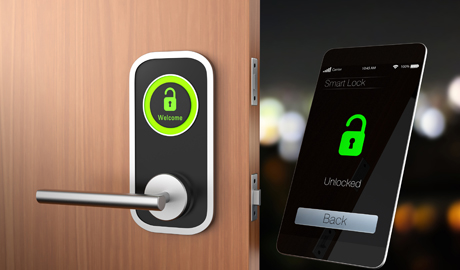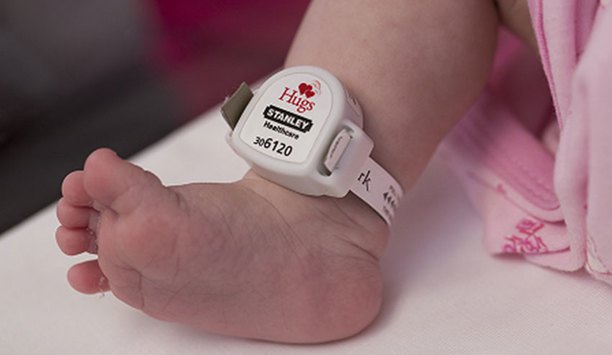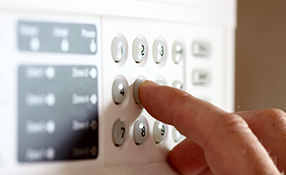 |
| Wireless offers many opportunities for security contractors to increase the base of installations and add subscribers |
Security installation contractors have many different choices when it comes to wireless signaling technologies for their customers. Radio frequency (RF) communications have become more reliable, more robust and include inherent safeguards, such as encryption, to prevent hacking or takeover of wireless devices. Wireless can also allow for remote programing, depending on the device, thus providing additional time savings in the field.
For security contractors, wireless offers many opportunities to increase the base of installations and add subscribers. It could benefit an existing customer who wants to add security at a single door at the inside or outside of the premises, or at a remote location. It’s the perfect add-on solution and offers considerably less installation time compared to running wire or cable or, especially, digging and trenching. As a hybrid solution or standalone specification, wireless is definitely a technology to watch in 2016.
Changes In Demand For Read-Range Technologies
Longer-range, contactless systems can be used standalone or piggybacked on hands-free and even smart card access control systems. For the last 20 years or so, the proximity card, which uses 125 KHz technology, has been a mainstay, but in the last decade proximity cards have been bolstered by the smart card, which operates at 13.56 MHz. Most recently, the security industry has seen increased demand for read-range technologies that operate at 433 MHz for gated communities, parking structures, multifamily residential, commercial and other nascent markets. Although long-range reading is not new, changes in standardization are making it more popular: 433 MHz is a standard harmonized around the world, so receivers can be used globally – another plus for the installer.
For intrusion detection, two of the most common radio frequencies deployed are 900 MHz and 2.4GHz; 900 MHz penetrates obstructed locations and 2.4 GHz travels across long distances. These open frequencies have strong penetration even through channel interference and signal echo, which traditionally bounced signals off larger objects and diminished quality communication, now addressed with transmission and modulation schemes such as Frequency Hopping Spread Spectrum.
In both commercial and especially residential applications, communication possibilities include ZigBee, Z-Wave, Bluetooth and WiFi.
 |
| Wireless connectivity protocols offer direct connectivity to locks with the smartphone, as well as real-time updates of lock status |
ZigBee, an Institute of Electrical and Electronics Engineers (IEEE) 802.15.4-based specification offers users the ability to process many access control transactions and a high throughput, with low bandwidth consumption and a long battery life. It also offers real-time updates of lock status. WiFi, which provides a distributed topology, can be used for campuses, office parks and others with a secure WiFi network for fast communications and to push lots of data.
ZigBee Vs. WiFi - Finding The Right Wireless Fit
Peter Boriskin, Vice President of Commercial Product Management for ASSA ABLOY Americas, New Haven, Connecticut, says that the company’s research and development indicated that in the commercial market users were basically split along the lines of those who wanted an online hardwired solution, but also needed to extend the reach of their commercial systems without disturbing the existing infrastructure. Boriskin has more than 18 years of experience working with security technology primarily in the enterprise security marketplace.
“Certain signaling technologies are a better fit depending on the nature of the protected premises and what the user wants to accomplish,” Boriskin says. “We have been focused on delivering solutions primarily through ZigBee and WiFi. For customers who need real-time updates, ZigBee is the driving force; for those who need the distributed network of intelligent solutions, then it’s WiFi,” he says.
Z-Wave has traditionally been the most common wireless protocol in home automation products. Bluetooth, and now Bluetooth Smart, offer direct connectivity to locks with the smartphone and do not require WiFi when in range. Bluetooth Smart is the intelligent, power-friendly version of Bluetooth wireless technology, according to the Bluetooth Special Interest Group (SIG), Kirkland, Washington. And as interest increases in the Internet of Things, residential wireless communications technologies like Z-Wave and Bluetooth Smart will continue to find new practical applications while new sensors and gateways develop to present greater functionality in the home.
Wireless extends the realm of installation possibilities for the security contractor. There’s a communication technology suited for every user and vertical market.











































